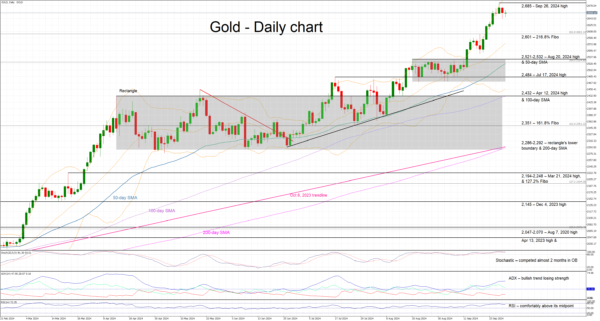- Gold is trading sideways today, but close to recent highs
- Volatility drops as a key US data week starts
- Momentum indicators are less bullish at this juncture
Gold is trading sideways today, a tad below its recent all-time high of 2,685. With the dollar remaining on the back foot, the market is preparing for an action-packed week with Friday’s non-farm payrolls figure being the highlight of the US data calendar. As such, gold traders could be taking a breather after another strong weekly performance, with one eye on the developments in the Middle East.
In the meantime, the momentum indicators are slightly less bullish. The RSI remains above its midpoint, but it is clearly edging lower. Similarly, the Average Directional Movement Index (ADX) is hovering well above its 25 midpoint. However, it is showing little appetite for a move higher and therefore points to a slightly weaker bullish trend in gold. More importantly, the stochastic oscillator has completed 50 days inside its overbought territory (OB), but it has crossed below its moving average (MA). Should this move lower continue, it could be seen as a strong bearish signal.
If the bulls remain confident, they could try to regain the market reins and gradually overcome the all-time high at 2,685. If successful, they would enter uncharted waters again, with the next plausible targets being the 2,700 and 2,750 levels respectively, which could easily be broken if market forces remain very strong.
On the flip side, the bears are keen for a long-overdue correction. They could push gold towards the 261.8% Fibonacci extension of March 8, 2022 – September 28, 2022 downtrend at 2,601, but their main target is probably the busy 2,521-2,532 area. This is populated by the August 20, 2024 high and the 50-day simple moving average (SMA). Even lower, the bears could then test the support set by the July 17, 2024 high at 2,484.
To sum up, gold traders could be staying on the sidelines ahead of this week’s rich data calendar that could play a key role in the next leg in gold.














